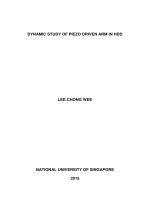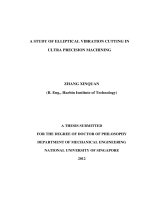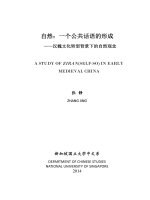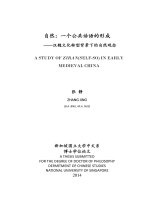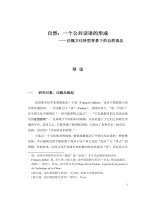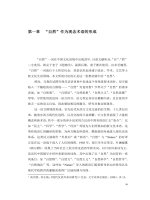Study of domain wall devices in magnetic nanowires
Bạn đang xem bản rút gọn của tài liệu. Xem và tải ngay bản đầy đủ của tài liệu tại đây (4.43 MB, 139 trang )
STUDY OF DOMAIN WALL DEVICES IN
MAGNETIC NANOWIRES
KULOTHUNGASAGARAN NARAYANAPILLAI
(B.Eng. (Hons.), Multimedia University, Malaysia)
A THESIS SUBMITTED FOR THE DEGREE OF
DOCTOR OF PHILOSOPHY
DEPARTMENT OF ELECTRICAL AND COMPUTER
ENGINEERING
NATIONAL UNIVERSITY OF SINGAPORE
2013
ii
DECLARATION
I hereby declare that the thesis is my original work and it has been written by
me in its entirety. I have duly acknowledged all the sources of information
which have been used in the thesis.
This thesis has also not been submitted for any degree in any university
previously.
____________________________
Kulothungasagaran Narayanapillai
August 6, 2013
iii
ACKNOWLEDGEMENTS
I would like to take this opportunity to thank everyone who made this
work possible. First and foremost, I would like to express my utmost gratitude
to my mentor and supervisor, Prof. Hyunsoo Yang, for giving me this
wonderful opportunity to be part of his multidisciplinary research team.
Throughout the last four years of my study period, his continuous guidance,
encouragement and kind support have greatly shaped me into what I am today.
In fact, I am quite lucky to be part of this ambitious research team.
I would like to extend my gratitude to Prof. Charanjit Singh Bhatia for
his continued support. I would like to thank my thesis committee Prof.
Thomas Liew and Prof. Teo Kie Leong for their valuable suggestions. I am
grateful to my seniors Xuepeng, Sankha, Gopinadhan, Jan, Surya, Ajeesh,
Young Jun, Jae Hyun, Jae Sung, Mustafa and Mahdi for teaching me the art of
scientific research and collaborating with me in my research endeavors. I also
cherish the moments with my colleagues Praveen, Siddharth, Niu Jing, Shreya,
Karan, Wu Yang and Li Ming for the fun and adventures in the lab, late
dinners and fruitful discussions. Naganivetha, Junjia, Xinming, Shimon, Anil,
Arkajit, Sandeep, Mridul, Sajid, Reuben, Shawn, Ramanathan Ghandi,
Panneerselvam and Jungbum are few of the wonderful friends I made during
the PhD journey. I would like to extend my special thanks to our lab managers
Robert and Ms. Fong Leong. Over and above, I would like to thank each and
every SEL and ISML members for their unconditional support through the
years.
Most importantly, I would like to extend my thanks to my family
members, especially my parents for their love, support and blessings. Also,
thanks to my lovely wife Sulekha for her love and patience over these years.
iv
TABLE OF CONTENTS
Chapter 1 : Introduction 1
1.1 Introduction to storage and logic devices 1
1.2 Magnetic nanowire based storage and logic devices 3
1.3 Theory of ferromagnetic domains 4
1.3.1 The concept of magnetic domains 4
1.4 The energetic contributions to a ferromagnet 6
1.4.1 The total free energy of a ferromagnet 6
1.4.2 Exchange energy 6
1.4.3 Magneto crystalline anisotropy energy 7
1.4.4 Magnetoelastic energy 8
1.4.5 Magnetostatic energy 9
1.4.6 Zeeman energy 9
1.5 Magnetization dynamics 10
1.5.1 Damping 10
1.6 1D domain wall model 12
1.6.1 Wall types in nano-strips 13
1.7 Recent development in domain wall based devices 17
1.8 Micromagnetic simulations 20
1.8.1 Cell size and exchange length 20
1.8.2 Simulation geometry 21
1.9 Objectives 22
1.10 Organization of the thesis 22
Chapter 2 : Experimental techniques 24
2.1 Thin film deposition processes 24
2.1.1 Magnetron sputtering 24
2.2 Device fabrication 26
2.2.1 Sample preparation 26
2.2.2 Photolithography 26
2.2.3 Electron beam lithography 28
2.2.4 Dry etching 29
v
2.2.5 Pattering techniques 31
2.3 Structural and magnetic characterization techniques 34
2.3.1 Magnetic force microscopy (MFM) 34
2.3.2 Superconducting quantum interference device (SQUID) 35
2.4 Electrical characterization 37
Chapter 3 : Domain wall characterization 39
3.1 Introduction 39
3.2 Field driven domain wall motion in permalloy nanowires 39
3.2.1 Domain wall generation by shape anisotropy 39
3.2.2 Field driven motion of head to head DWs 41
3.2.3 Field driven motion of tail to tail DWs 42
3.3 Electrical characterization of magnetic DWs 43
3.3.1 Measurement set up 43
3.3.2 DW generation with nucleation pad geometry 44
3.3.3 Domain wall resistance 46
3.3.4 DW generation by Oersted field generation method 48
3.4 Field driven domain studies in perpendicular magnetic anisotropy
(PMA) systems 53
3.4.1 Experimental setup 53
3.4.2 Sample preparation 53
3.5 Summary 56
Chapter 4 : Domain wall pinning at nanotrench pinning sites 57
4.1 Motivation 57
4.2 Introduction 57
4.3 Simulation studies on pinning sites 59
4.3.1 Nanotrench pinning site 59
4.3.2 Depinning field studies on nanotrench and V-notch 60
4.4 Energy profile of pinning sites 65
4.4.1 Nanotrench pinning site 66
4.4.2 V-notch pinning site 69
4.5 Experimental studies with nanotrench pinning site 72
4.5.1 Device preparation 72
4.5.2 Experimental schematics 72
vi
4.5.3 Domain wall generation 73
4.5.4 Domain wall depinning 76
4.6 Conclusions 79
Chapter 5 : Thermally assisted domain wall nucleation in
perpendicular magnetic trilayers 81
5.1 Motivation 81
5.2 Introduction 81
5.3 Perpendicular anisotropy trilayer system – film preparation 83
5.4 Experimental schematics 85
5.5 Thermally assisted domain wall nucleation 86
5.5.1 Effect of assist field 92
5.5.2 Effect of pulse width on current density 92
5.5.3 Domain wall nucleation in sample B 93
5.6 Thermal analysis on the switching process 95
5.7 Domain wall depinning from the Hall-cross pinning sites 97
5.8 Determination of the effective perpendicular anisotropy field 98
5.9 Conclusions 100
Chapter 6 : Magnetocapacitance in ferromagnetic nanowires 101
6.1 Motivation 101
6.2 Introduction 101
6.3 Experimental details 102
6.4 Magnetocapacitance in permalloy nanowires 103
6.4.1 Nanowire width dependence of magnetocapacitance 105
6.5 Cole-cole plot 106
6.6 Equivalent circuit model 107
6.7 Angular dependence of magnetocapacitance 109
6.8 Magnetocapacitance in perpendicular anisotropy nanowires 111
6.8.1 Experimental details 111
6.8.2 Measurement details 113
6.9 Conclusions 114
Chapter 7 : Conclusions and future works 116
7.1 Conclusions 116
vii
SUMMARY
Domain wall based devices have been intensively studied recently for
the next generation 3-dimensional memories and logic systems. In this thesis,
we have studied in-plane and out-of-plane anisotropy systems for domain wall
device applications. For the in-plane anisotropy, NiFe has been investigated. It
has a large anisotropic magnetoresistance as well as a very low
magnetostriction coefficient. Co/Pd multilayers and CoFeB based tri-layer
systems such as Pt/CoFeB/MgO and Ta/CoFeB/MgO are utilized for the
perpendicular anisotropy. Tri-layer systems are a popular choice for future
spintronics applications including domain wall devices due to the ability to
tailor the magnetic properties such as perpendicular anisotropy,
magnetostriction, critical current density as well as the newly discovered
current induced spin orbit torques. Important aspects in the domain wall based
devices such as domain wall generation, propagation, and detection are
studied.
The design of pinning sites is crucial for the control of domain walls in
nanowires. The most common approach to pin a domain wall is by introducing
a constriction along the lateral edge of the nanowire. The parameters such as
pinning fields and pinning potentials highly depend on the notch dimensions.
The reproducibility and control of lateral dimensions are quite challenging in
lithography. An alternative approach to pin a domain wall is investigated in
this work. The pinning sites are created by etching out a selected portion of the
magnetic nanowire, thus forming a vertical nanotrench across the whole width
of the nanowire in contrast to the conventional approaches with a lateral trench
across the small portion of the nanowire. The micromagnetic simulations show
that the pinning strength can be effectively controlled by a proper selection of
nanotrench dimensions. Different shapes of the potential profile are observed
for transverse and vortex type domain walls. The symmetric nature of the
nanotrench pining site offers less complicated domain wall evolution at the
pinning site compared to the conventional the lateral V-notches. In permalloy
nanowires with nanotrench pinning sites, both vortex and transverse types of
domain walls have been experimentally shown to exist. Reliable pinning and
depinning behaviors from a vertical nanotrench are observed. Compared to the
viii
lateral constrictions, our proposed method has a higher precision in defining
the dimensions of the pinning sites in the sub-nanoscale.
An alternative method to generate domain walls at predefined positions
along the nanowire with the assistance of Joule heating is investigated in
perpendicular anisotropy trilayers. The nanowire coercivity (H
C
) is reduced by
the Joule heating. When the assist field overcomes H
C
, the part of the
nanowire that experiences Joule heating undergoes magnetization reversal.
The required current densities to generate domain walls are effectively
controlled by the proper selection of the pulse width and the constant assist
field, which is applied during the current pulse. The statistical analysis shows
that this method allows to selectively generate a domain wall at a predefined
location in perpendicular magnetic anisotropy nanowires with great
reproducibility. This is challenging with other DW generation procedures
based on random nucleation sites. The pulse width dependent analysis using
modified Sharrock‟s equation confirms the Joule heating process. The
proposed method can be extended to generate any desired number of domain
walls in a single nanowire with relative ease compared to the Oersted field
generation method.
Magnetic domain wall induced capacitance variation is investigated as
a tool for the detection of magnetic reversal in magnetic nanowires for in-
plane (NiFe) and out-of-plane (Co/Pd) magnetization configurations. The
switching fields in the capacitance measurements match with that of the
magnetoresistance measurements in the opposite sense. The capacitive
behavior of the nanowire system is analyzed based on the modified Maxwell-
Wagner capacitance model. The origin of the magnetocapacitance has been
attributed to magnetoresistance. This magnetocapacitance detection technique
can be useful for magnetic domain wall studies.
ix
List of Tables
Table 3-1: The measurement sequence and field cycle employed to detect the
DW at the notch. 46
Table 3-2: Field sequence applied for during measurements to generate and
detect DWs. The resistance levels measured at the corresponding
fields is shown on the right column. 50
Table 6-1: Fitting parameters from the ∆R and ∆X. 109
x
List of Figures
Figure 1-1: (a) Example of an innately three-dimensional microelectronics
device. (b) Schematics and working principle of a vertical
racetrack [7]. 3
Figure 1-2: Schematics of a DW based storage device – lateral racetrack
memory (RM) [16]. 3
Figure 1-3: (a) A saturated structure with higher magnetostatic energy
contribution. The magnetostatic energy is reduced by forming
domain structures from (b) to (d). There considerable reduction in
stray field in (d) is due to the lack of free poles on the sample
surface. 6
Figure 1-4: Magnetization precession. 10
Figure 1-5: The definition of co-ordinate system used to describe in the 1D
model of DW profile. 12
Figure 1-6: Magnetization profile with three regions in a simplified model. 12
Figure 1-7: Transverse wall in a nanostrip (width – 120 nm; thickness – 5 nm;
cubic mesh 5 × 5 × 5 nm
3
). (a) Arrows show the magnetization
direction. (b) Comparison of the micromagnetic simulation with
the 1D model [25, 26]. 14
Figure 1-8: Vortex wall in a nanostrip (width – 240 nm; thickness – 10 nm;
cubic mesh 5 × 5 × 5 nm
3
). (a) Arrows show the averaged
magnetization in axial m
x
and transverse m
y
direction. (b)
Comparison of the micromagnetic simulation with the 1D based
model [25, 26]. 15
Figure 1-9: Domain wall structures in nano-strips with magnetization along
the longitudinal direction. (a) Symmetric transverse wall. (b)
Vortex wall. (c) Asymmetric transverse wall [25]. 16
Figure 1-10: Phase diagram of the domain wall structure in permalloy nano-
strips [27]. 16
Figure 1-11: Four different types of DWs in permalloy nanowire. (a) and (b)
show clockwise transverse and vortex walls while (c) and (d)
show anti-clockwise transverse and vortex walls, respectively.
The corresponding simulated divergence and the magnetization
profile are also shown [28]. 17
Figure 1-12: Critical current density for DW motion in permalloy nanowires.
For nanowires thinner than 40 nm, the reported critical current
densities are 5 - 30×10
7
A/cm
2
[37]. 18
xi
Figure 1-13: A long nanowire is divided into three parts. The left and the right
parts have fixed magnetization values. The middle portion has the
domain wall [25]. 21
Figure 2-1: Dc-magnetron deposition process. The sputter target is placed on
top of permanent magnets and the substrate is directly on top of
the target. Line of force of magnetic field is also shown in the
diagram [57]. 25
Figure 2-2: A sputter deposition system used for magnetron sputtering. The
power supplies and the deposition chamber are visible in the
image [59]. 25
Figure 2-3: Photomask is used to selectively block the UV-irradiation. The
resist gets exposed through the quartz region of the mask. 27
Figure 2-4: A MA6 Karl Suss mask aligner used for photolithography [60]. . 27
Figure 2-5: Raith e-line lithography system is used for lithography [63]. 28
Figure 2-6: An ion milling system used for etching. Ar plasma is utilized for
milling [63]. 30
Figure 2-7: Lift – off process in details. (a) Exposure of e-beam for patterning.
(b) E-beam profile – interaction of the resist with secondary and
backscattered electrons. (c) The development process. (d) Metal
deposition process. (e) Lift-off process. The unexposed resist with
the metal on top is removed inside acetone. 31
Figure 2-8: Lithography steps with negative resist. (a) The film coated with
negative resist is exposed with the desired patterns by EBL. (b)
Electron beam profile inside the resist with the backscattered and
secondary electrons. (c) Developing the exposed patterns. (d) Ion
milling process to remove the metal area not covered by EBL
resist. (e) Removal of EBL resist in acetone or negative resist
remover. 33
Figure 2-9: Working principle of an MFM system. First the topographic
information is recorded, and then the lift-mode scan is performed
[65]. 34
Figure 2-10: Veeco® scanning probe microscopy system. The system is
shielded during measurements isolate the measurement system
from the outside magnetic noise. 35
Figure 2-11: Working principle of a SQUID. 36
Figure 2-12: SQUID – MPMS system used for measurements [69]. 36
Figure 2-13: Four probe station utilized for dc- and ac-measurements. 37
xii
Figure 2-14: (a) He4 cryostat system with magnetic poles. Ac and dc
measurement and control equipment are visible on the rack. (b)
Electrodes on the substrate are wire bonded to the terminals in the
sample holder. 8-terminals can be used for measurements. 38
Figure 3-1: Generation of a DW by magnetic field utilizing the shape
anisotropy. (a) Saturation magnetic field is (H
SAT
) applied along x-
direction. (b) Alignment of magnetic moments when the applied
field is gradually reduced. The magnetic moments stay parallel to
the nanowire edges due to shape anisotropy. (c) The dotted area
shows a generated HH-DW after the field is removed. (d) A TT-
DW is formed with saturation magnetic field in –x-direction. 40
Figure 3-2: MFM images show a HH and TT – DW configuration formed after
saturating the nanowire (width: 700 nm) in the +x- and –x-
direction, respectively. 41
Figure 3-3: MFM images of depinning a HH-DW by external magnetic field,
H
A
applied in the depicted direction. At 70 Oe, the DW is
depinned from the pinning site. 42
Figure 3-4: MFM images of depinning a TT-DW by external magnetic field,
H
A
applied in the depicted direction. At 30 Oe, the DW is
depinned from the pinning site. 43
Figure 3-5: (a) The measurement pad design with nanowire at the center. The
inset shows a representative notch. (b) SEM image of the device
with four probe measurement scheme. A lock in amplifier with an
external resistance (R
EX
) is connected to the nanowire. 44
Figure 3-6: Generation of a DW utilizing the nucleation pad geometry. (a) The
nanowire is saturated along +x-direction. (b) When H
NUC
is
applied, the pad reverses first and a DW is formed at the mouth of
nanowire. (c) Further increase in H
NUC
releases the DW and
subsequently pushes the DW towards the notch. (d) The entire
wire is saturated along the –x-direction. 45
Figure 3-7: (a) Device structure with the notch position (b) AMR response of a
700 nm wide nanowire with magnetic field. 45
Figure 3-8: Repeated measurements following the scheme shown in Table 1
with H
NUC
= -45 Oe (a) and H
NUC
= -130 Oe (b-d). (b) DW
generation failures are highlighted. (d) Different resistance levels
observed for generated DWs. 47
Figure 3-9: MFM image shows a DW trapped at the pinning site by the pad
nucleation method. The notch position in the nanowire is also
shown. 47
Figure 3-10: Schematics of Oersted field generated by a current carrying
conductor. The generated Oersted field is in the (a) parallel and
xiii
(b) anti-parallel with magnetization underneath the conductor. (c)
The Oersted field profile of H
X
and H
Z
along the length of the
sample. 49
Figure 3-11: (a) Cross sectional view of simulation setup – a current carrying
conductor is placed on top of the magnetic nanowire. (b) After the
current pulse is applied, a portion of the magnetic nanowire is
reversed, resulting in two vortex DWs. The arrows indicate the
direction the magnetization. 50
Figure 3-12: (a) Measurement schematics for DW generation and detection.
(b) Five possible magnetization states after the DW generation
pulse. 51
Figure 3-13: Resistance values across CB. (a) Two DWs are generated. (b) A
single DW generated. (c) Whole nanowire is reversed. (d) No DW
was generated. 52
Figure 3-14: (a) Mask patterns for etching. (b) Device schematics with a step
in the middle of the nanowire. 54
Figure 3-15: (a) Topography and (b) Phase diagram of a freshly prepared
Co/Pd multilayer nanowire with the step like structure. Multi-
domain structure is clearly visible. 54
Figure 3-16: (a) Phase diagram of a single DW pinned at the edge of the step
(circled). (b) Phase diagram after saturation. 56
Figure 4-1: (a) A lateral notch with constriction [82]. (b) A lateral notch with
protrusion [85]. 58
Figure 4-2: Proposed vertical notch, „nanotrench‟. 59
Figure 4-3: (a) Schematics of a nanotrench. Initialized (b) transverse and (c)
vortex domain wall at the nanotrenches. The dark shade highlights
the area of nanotrench. 60
Figure 4-4: (a) Schematics of V-notch. Initialized (b) transverse and (c) vortex
domain wall at the V-notches. 60
Figure 4-5: Evolution of transverse DWs during the depinning process at a
nanotrench (a) and a V-notch (b). 61
Figure 4-6: Depinning strength of transverse DWs. (a) and (b) show the
depinning strength with respect to depth of notches (DN) for
nanotrench and V-notch respectively. (c) and (d) show the
depinning field dependence for length of notch (LN) for both
cases. 62
Figure 4-7: Vortex DW evolution during the depinning process at nanotrench
(a) and V-notch (b). The DW significantly expands due to the
Zeeman energy in the direction of the magnetic field. 63
xiv
Figure 4-8: Depinning strength of vortex DWs. (a) and (b) show the depinning
strength with respect to depth of notches (DN) for nanotrench and
V-notch, respectively. (c) and (d) show the depinning field
dependence for length of notch (LN) for both cases. 64
Figure 4-9: (a) A transverse DW is initialized at -1.5 µm away from the center
of the nanotrench. (b) and (c) shows the field induced DW motion
in different locations along the nanowire (DW position = -0.35,
0.6 µm). 65
Figure 4-10: (a) Normalized energy profile for separate energy terms with
respect to DW position for transverse DW for a nanotrench. (b)
Total energy for various lengths of notches with respect to DW
position for transverse DW. The inset shows the drop in energy in
the potential well with respect to the energy at the position of 500
nm. 67
Figure 4-11: (a) Normalized energy profile for separate energy terms with
respect to DW position for vortex DW for nanotrench. (b) Total
energy for various lengths of notches with respect to DW position
for vortex DW. The inset shows the drop in energy in the potential
well with respect to position 500 nm. 69
Figure 4-12: (a) Normalized energy profile for separate energy terms with
respect to DW position for vortex DW for V-notch. (b) Total
energy for various lengths of notches with respect to DW position
for vortex DW. 70
Figure 4-13: (a) Nanowire with a notch after the magnetization relaxing
process. (b) Total energy along the nanowire position. 71
Figure 4-14: (a) A simulated DW at the V-notch (b) Total energy for various
lengths of notches with respect to the DW position. 71
Figure 4-15: SEM micrograph with the measurement schematics. The etched
out nanotrench is highlighted in red shade. 72
Figure 4-16: Measurements of R
DW
in a series of experiments in which the
wire is first magnetized and a DW is subsequently injected. 74
Figure 4-17: (a) Contour plot for DW resistance (R
DW
) with respect to H
INJ
.
Four different resistance regions are visible. (b), (c), and (d) show
the histogram plot for H
INJ
= 10, 20, and 30 Oe, respectively. 75
Figure 4-18: Typical DW depinning profile as a function of applied magnetic
fields at the nanotrench pinning site. The abrupt change in the
resistance values show the depinning field at which the DW is
pushed out of the nanowire. 76
Figure 4-19: Histogram of depinning fields for the DWs generated at
nanotrench pinning site. 77
xv
Figure 4-20: (a) Histogram of DW resistance with H
INJ
= 30 Oe. (b) The
histogram of the depinning fields for the DWs generated in (a).
Histogram of depinning fields for (c) |R
DW
| > 0.14 Ω, (d) 0.14 Ω >
|R
DW
| > 0.10 Ω, and (e) |R
DW
| < 0.10 Ω. 78
Figure 4-21: (a) SEM image of the nanowire with the constriction. (b)
Depinning field with increasing constriction width [94]. 79
Figure 5-1: Domain wall generation methods in perpendicular anisotropy
systems. (a) Nucleation pad assisted [100]. (b) Oersted field [101].
(c) Anisotropy tailored by controlling multilayers [78]. (d) Ion
irradiation [103]. 82
Figure 5-2: (a) Schematics of heat assisted magnetic recording (HAMR) in
media. (b) Working principle of HAMR. The coercivity is reduced
by increasing the temperature to enable writing in lower field
[111]. 83
Figure 5-3: Trilayer structures studied for perpendicular anisotropy. (a) Heavy
metal is at the bottom. (b) Heavy metal is on top. 84
Figure 5-4: SQUID measurements on CoFeB trilayer films in the out-of-plane
measurements. The thickness of the ferromagnetic layer is
changed from 6 to 20 Å. 84
Figure 5-5: SEM micrograph of a 600 nm wide nanowire with 3 Hall bars
placed 8 µm apart from each other. A dc-current is used to detect
anomalous Hall signals across the three Hall bars. 85
Figure 5-6: Anomalous Hall measurements across Hall bars at 6 K. The abrupt
switching shows that all three Hall bars switch at the same field.87
Figure 5-7: Temperature dependence of the coercivity of the nanowire in the
out-of-plane direction. Inset shows the trilayer stack. 87
Figure 5-8: Working mechanism of the thermally assisted DW generation. (a)
The Hall loop at 6 K. The set assist field is indicated by the dotted
lines. (b) The temperature dependency of the coercivity. The
arrows show the temperature increase and its corresponding
decrease in coercivity. 88
Figure 5-9: (a) Device structure with measurement schematics. The red color
highlights the heated portion of the nanowire. (b) Hall bar
readings show the state of magnetization. Black and red colors
indicate opposite directions of magnetization state. 89
Figure 5-10: (a) AHE measurements across VH
1
for the pulse with 1 ms pulse
width applied across X
1
B
1
for a positive assist field. (b) Histogram
and cumulative probability of the switching processes positive
assist field. (c) and (d) shows the respective AHE measurements
and the histogram with cumulative probability for a negative assist
field. 91
xvi
Figure 5-11: Switching pulse amplitude with 1 ms pulse width for various
assist fields for positive and negative current polarities. 92
Figure 5-12: Switching pulse amplitude and the respective current density for
50 µs pulse width. 93
Figure 5-13: The temperature dependence of coercivity for sample B. The
inset shows the Hall loop for sample B at 6 K. 94
Figure 5-14: Switching pulse amplitude with 1 ms pulse width for various
assist fields. 94
Figure 5-15: The temperature dependence of coercivity for sample C. 95
Figure 5-16: Experimental data for J
2
versus the pulse width with fits. 96
Figure 5-17: (a) Schematics of a generated DW. (b) A typical Hall resistance
response of a DW depinning process at 260 K across VH
2
. 97
Figure 5-18: Strength of depinning fields and respective coercive fields at
different temperatures. 98
Figure 5-19: (a) In-plane magnetic field H
in−plane
dependence of the normalized
Hall resistance in sample A. (b) The normalized in-plane
component of the magnetization is determined from normalized
R
Hall
. 99
Figure 6-1: SEM micrograph of an 800 nm wide nanowire with electrical
leads. 103
Figure 6-2: MFM image of a vortex domain wall formed at the center of the
semi-circular nanowire. 103
Figure 6-3: (a) Resistance of the nanowire under ac-impedance measurements
across P
1
P
2
. (b) Capacitance measurement across P
1
P
2
. 104
Figure 6-4: Magnetoresistance and magnetocapacitance ratio for various
widths of nanowires. 106
Figure 6-5: R-X plot for the frequency range 50 Hz – 2 MHz. The absolute X
component is plotted with a circular fit. 106
Figure 6-6: (a) Equivalent circuit for the measurement set up with two leaky
capacitors representing the nanowire and the rest corresponding to
the other effects arising from the coaxial line and contacts. (b)
Simplified equivalent circuit with the field dependent components
(C
M
and R
M
) and others (Z
T
). 107
Figure 6-7: R component of impedance spectroscopy (IS) at two different
magnetic fields. The insets show R with fits. 108
xvii
Figure 6-8: X component of impedance spectroscopy (IS) at two different
magnetic fields. The insets show X with fits. 109
Figure 6-9: (a) Angular dependence of resistance. (b) Angular dependence of
magnetocapacitance for various angles. 110
Figure 6-10: (a) Stack structure of Co/Pd multilayer film. (b) VSM
measurements on Co/Pd thin film at room temperature. (c)
Schematics of the measurement setup for Hall measurements. (d)
Normalized anomalous Hall effect measurements at 6 K. 112
Figure 6-11: SEM image with measurement schematics for capacitance
measurement. 113
Figure 6-12: (a) Resistance of the nanowire under ac-impedance
measurements across B
2
C
2
. (b) Capacitance across B
2
C
2
. 114
Introduction
1
Chapter 1 : Introduction
1.1 Introduction to storage and logic devices
The ability to manipulate the electron‟s spin has paved the way for the
next emerging branch in electronics – spintronics. Information is stored in the
form of spin orientation in storage devices such as hard disks. Recent
developments in nano-lithography have enabled applications of spin based
devices in nano-scale. Advances in generating, manipulating and detecting
spin-polarized electrons and electrical currents make possible new classes of
spin based sensor, memory, and logic devices. The discovery of giant
magneto-resistive (GMR) spin valve sensors has had an enormous impact on
hard disk sensors [1-3]. The areal density of the hard disk shot up to 10 times
in a short span of time [4]. The development of magnetic tunnel junction
(MTJ) has further driven the areal density. A MTJ is a sandwich of thin layers
of metallic ferromagnetic electrodes separated by a tunneling barrier (typically
an oxide material) of a few atoms thick. Furthermore, a new class of memory
based on MTJs is also under development which promises a high performance
memory with a high density, speed, and non-volatility [5, 6]. However, the
current developments in industrial products are approaching lithography
limits. One of the possibilities to overcome this lithography limitation is to
store information in 3-dimensional structures as in the proposed race-track
memory system, where information is stored in the form of domain walls
(DWs) [7]. The DW based memory system is widely heralded as a future
storage system due to its inherent superior qualities such as a higher storage
density, projected reliability, and lifetime of the devices. These DW based
devices have a wider range of applications which can be extended to nano-
oscillators and logic devices [8-10].
Introduction
2
One of the challenges to realize DW based devices is the higher critical
current density to move the DW in the direction of the electron flow. NiFe has
been studied extensively as the basic material due to its ease of detection via
anisotropic magnetoresistance (AMR) and negligible magnetostriction.
However, NiFe suffers from issues such as the high critical current density,
large domain wall size, etc. The solution lies in engineering the materials
stacks as well as looking into new detection techniques other than AMR,
which would pave a way for implementation of new material systems.
Perpendicular material structures have been proposed due to its
superior properties over in-plane anisotropy materials. There have been
considerable research in Co/Ni and Co/Pt perpendicular structures for DW
studies, where the film is ultra-thin [11]. While this ultra-thin material stacks
could be challenging to implement due to the sensitive dependence on the
layer structures, it also offers the possibility of improving the heat dissipation
by choosing appropriate layers. The recent discoveries of the Rashba [12] and
spin Hall effect [13, 14] in metallic systems have shown another degree of
freedom to engineer such material structures where an effective magnetic field
appears to oppose or support the direction of the spin transfer torque. These
effects also provide means to reduce the critical current density coupled with
the existence of Dzyaloshinskii-Moriya interaction (DMI).
Another challenge is the design of pinning sites for DWs in nanowires.
The DW behavior at the pinning site strongly depends on its geometry.
Pinning sites in the shape of triangles and rectangles forming lateral
constrictions along the nanowire are widely studied [15]. These pinning sites
increase the potential barrier to overcome for motion of DWs. Even though the
pinning potential can be modeled with software assistance, the real
phenomena where the current density significantly changes around the notch
will be difficult to model due to the spurious effects of the Joule heating.
Moreover, the pinning notches could be implemented in vertical dimensions.
However, a systematic study in three dimensional systems such as a vertical
notch in nanowires has been not reported yet.
In order to realize DW based devices, improving DW generation,
control, and detection are a few important aspects which should be taken into
Introduction
3
consideration. In this thesis, we study and implement new strategies to address
these challenges.
1.2 Magnetic nanowire based storage and logic devices
IBM scientists have envisioned a new memory system where bits of
information are stored as magnetic domains in nano-sized magnetic wires
known as “racetrack memory”. This is an example of three-dimensional
microelectronics devices. This new class of memory promises features such as
high performance, low cost, and non-volatility [7].
Short pulses of spin polarized currents are used to move DWs between
pinning sites. This memory scheme offers high performance, endurance of a
conventional solid-state memory device, and lower cost than flash drives.
Figure 1-1: (a) Example of an innately three-dimensional microelectronics
device. (b) Schematics and working principle of a vertical racetrack [7].
Figure 1-2: Schematics of a DW based storage device – lateral racetrack
memory (RM) [16].
Arrays of nanowires can be used to form the racetrack device where
these nanowires can be placed horizontally or vertically as in Fig. 1-1 or 1-2.
A single data bit can be stored in DWs between two successive magnetic
regions, which can be differentiated by the direction of local magnetization, or
by the presence and absence of DWs between these two regions.
(a)
(b)
Introduction
4
Mechanisms can be worked out to implement this device with writing
and reading schemes. A writing device can be used to inject DWs into the
nanowire, while a magnetic tunnel junction (MTJ) can be used as a read
sensor. Each racetrack (nanowire) requires only one pair of a read sensor and a
writing device. The magnetic bits/patterns can be moved around the nanowire
by applying nanosecond long pulses. Many DWs (as many as 10 – 100) can be
stored in a single racetrack. As a result, the stored number of data bits per unit
area can be increased dramatically compared to the conventional 2D random
access memories (RAM based technologies). It is expected that the vertical
racetrack memory could accommodate the storage density comparable to that
of a magnetic disk drive. Also, for the horizontal race track, the cell size can
be much smaller than the typical MRAM cell. It has been estimated that with a
proper selection of the materials, a data rate of 500 Mb/s can be reached in the
horizontal racetrack memory with power smaller than 1mW per racetrack
during the writing/shifting processes. There are a few demonstrations on
prototype of racetrack memories [16, 17].
Magnetic DW based logic devices are also proposed. Simple logical
operations such as NOT, AND, and signal cross-over elements are
demonstrated in permalloy by magnetic field rotation [8]. There are proposals
for extension of racetrack memories for logic applications [18]. A current
controlled magnetic DW nanowire shift register was experimentally verified
by Hayashi et al. A three-bit unidirectional magnetic DW shift register was
also demonstrated [9].
Recent developments in perpendicular magnetic anisotropy (PMA)
materials have significantly contributed to the improvements in DW based
devices and it has taken a step closer in realizing these proposals. Recent
developments in DW based systems are discussed in section 1.7.
1.3 Theory of ferromagnetic domains
1.3.1 The concept of magnetic domains
Ferromagnetic domain concept was developed by Weiss who
suggested the existence of magnetic domains in a ferromagnet. Based on the
Introduction
5
small regions (ferromagnetic domains), Weiss was able to explain the
existence of demagnetized state. A domain configuration is a resultant
consequence of the various contributions to the total energy of the
ferromagnetic body. The total energy of the ferromagnetic body consists of the
energy terms such as exchange energy, magnetocrystalline anisotropic energy,
magnetoelastic energy, and magnetostatic energy. Large magnetostatic energy
which is associated with the stray field can be decreased by forming a domain
structure. The domain structure can remove the uncompensated poles on the
surface of the specimen.
The magnetostatic energy associated with a stray field is given by,
2
0
2
s
s
E H dV
, where H
s
is the stray field and dV is the volume of space.
The magnetostatic energy is due to the interaction between magnetic dipoles.
The magnetic dipole-dipole interaction is very small compared to the strong
exchange interaction which is a very short range interaction. However, the
magnetic dipole-dipole interaction is long range and so this interaction is
important for magnetic moments that are separated by large distances. The
uncompensated free poles lead to the formation of a domain structure to
reduce the magnetostatic energy.
The structures shown in Fig. 1-3 clearly explain the formation of
domains. Figure 1-3(a) shows a single domain area which has higher stray
field, thus higher magnetostatic energy. In Fig. 1-3(b) the stray field is reduced
by approximately half. Similarly, in Fig. 1-3(c), the stray field is reduced to a
quarter of the value of (a), and in (d) the stray field is almost completely
removed.
However, forming domain structures take place at the expense of
increase in other energy components such as exchange energy. Eventually,
further subdivision into domains will continue only until the expense of
energy terms are equated by the reduction in magnetostatic energy, and
subsequently an equilibrium domain size will be attained. The energy terms in
this competition are discussed in the next section.
Introduction
6
Figure 1-3: (a) A saturated structure with higher magnetostatic energy
contribution. The magnetostatic energy is reduced by forming domain
structures from (b) to (d). There considerable reduction in stray field in (d) is
due to the lack of free poles on the sample surface.
1.4 The energetic contributions to a ferromagnet
1.4.1 The total free energy of a ferromagnet
The total free energy (E
total
) of a ferromagnetic system in
thermodynamic equilibrium is given by
0
total total
V
E dV
(1.1)
where
total
is the total free energy density of the system and V is the sample
volume. The total free energy density comprises of 5 energy terms which is
given by
total A K S Zeeman
(1.2)
The components are exchange (
A
), magnetocrystalline anisotropy (
K
),
magnetoelastic (
), magnetostatic (
S
), and Zeeman (
Zeeman
) energy
densities [19].
1.4.2 Exchange energy
A quantitative expression for exchange energy is obtained by the
following analysis. Assume two atoms with i and j have spin angular
momentum S
i
and S
j
. The exchange energy is given by the Vleck formula [20]
(a) (b) (c) (d)
Introduction
7
2
,
2 2 cos
ex ex i j ex i j
E J S S J S
(1.3)
where
ex
J
is the exchange integral and
is the angle between adjacent spins.
In the case of ferromagnetic materials, exchange integral is positive.
Therefore, the exchange energy is negative when adjacent spins are parallel,
and positive when the spins are anti-parallel. Exchange stiffness parameter, A
is defined as
2
ex
JS
A
a
(1.4)
where a is the lattice parameter. The exchange stiffness parameter gives a
measure of the energy, when nearest neighbor spins are not completely
parallel. For permalloy, the exchange stiff constant is 1.3 ×10
13
J/m [21].
1.4.3 Magneto crystalline anisotropy energy
The magnetocrystalline anisotropy energy prefers the magnetization to
be directed along certain definite crystallographic axes, which are also the
directions of “easy” axes of magnetization. On the other hand, the directions
which are difficult to align the magnetization in a crystal are called “hard”
axes. The cost of energy to align the magnetization in the hard axis rather than
the easy axis is known as the magnetocrystalline anisotropy energy.
For uniaxial crystals the magnetocrystalline anisotropy energy density
is given by
24
12
sin sin
K
KK
(1.5)
where
is the angle between the easy axis and the magnetization. Here,
higher order terms are neglected.
Magnetocrystalline energy is dominant in single crystal specimens. For
polycrystalline samples with random orientation of crystalline grains, this
energy averages out. Therefore, such samples exhibit no net
magnetocrystalline anisotropy, although there will be local distribution of
magnetization influenced by the local magnetocrystalline energy. However,
most of the polycrystalline samples have a preferred orientation or texture
which can be enhanced by the preparation technique. For permalloy, K
1
is very
Introduction
8
small and slightly negative, which indicates that easy axes of magnetization
corresponds to the [111] set of directions.
1.4.3.1 Surface anisotropy
The local environment of atoms differs at both surfaces of a thin film
with respect to the bulk one. Néel suggested that this breaking of symmetry
induced another magnetic anisotropy which is later known as surface magnetic
anisotropy or interface anisotropy. This effect becomes negligible if the
thickness is more than a few nanometers. In magnetic ultrathin films, the
anisotropy density is given by
2
sin
KA eff
K
(1.6)
where
is the angle between the normal to the plane and the magnetization.
K
eff
is given by
2
S
eff V
K
KK
t
(1.7)
where K
V
is the effective volume anisotropy constant (containing
magnetocrystalline terms) and K
S
is the effective surface or interface
anisotropy. The relationship is derived for the magnetic layer bounded by two
identical interfaces accounting for the prefactor 2. When K
S
favors the
alignment of magnetization along the normal to a thin film (K
S
< 0), it induces
perpendicular magnetic anisotropy. In such systems (Co/Pd, Co/Pt, Co/Au
multilayers), the typical thickness of the magnetic layer is less than 2 nm.
1.4.4 Magnetoelastic energy
The magnetoelastic energy arises from the interaction between the
magnetization and the mechanical strain of the crystal lattice. An applied field
re-orientates the spin moments and changes the magnetization direction. In
response to that, due to the spin-orbit interaction, the electron orbitals also try
to re-orientate. For 3d ferromagnetic elements, this effect is less. However, in
the rare-earth metals where the spin-orbit coupling is strong, this results in a
large reorientation of the electron orbits, when the magnetization direction is
changed. Magnetostrictive coefficient is (
) the fractional change in length as


